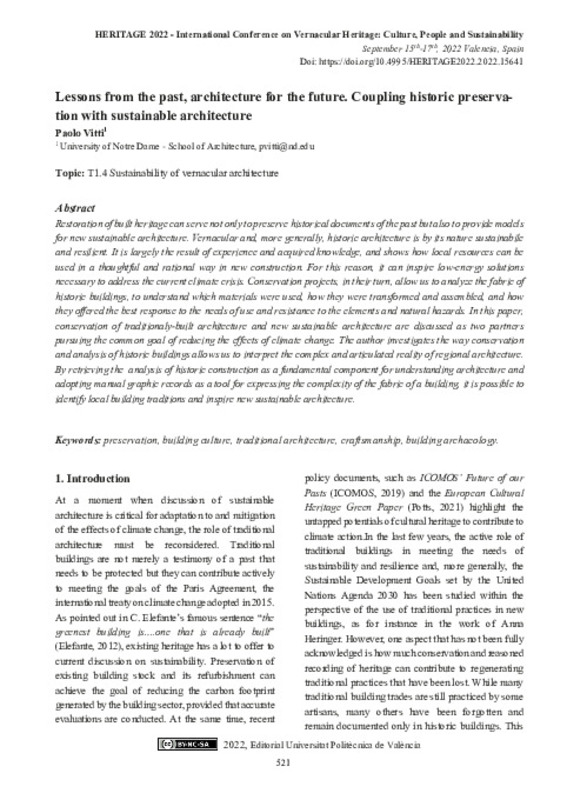JavaScript is disabled for your browser. Some features of this site may not work without it.
Buscar en RiuNet
Listar
Mi cuenta
Estadísticas
Ayuda RiuNet
Admin. UPV
Lessons from the past, architecture for the future. Coupling historic preservation with sustainable architecture
Mostrar el registro sencillo del ítem
Ficheros en el ítem
| dc.contributor.author | Vitti, Paolo
|
es_ES |
| dc.date.accessioned | 2022-11-02T11:25:17Z | |
| dc.date.available | 2022-11-02T11:25:17Z | |
| dc.date.issued | 2022-09-13 | |
| dc.identifier.isbn | 9788413960203 | |
| dc.identifier.uri | http://hdl.handle.net/10251/188990 | |
| dc.description.abstract | [EN] Restoration of built heritage can serve not only to preserve historical documents of the past but also to provide models for new sustainable architecture. Vernacular and, more generally, historic architecture is by its nature sustainabile and resilient. It is largely the result of experience and acquired knowledge, and shows how local resources can be used in a thoughtful and rational way in new construction. For this reason, it can inspire low-energy solutions necessary to address the current climate crisis. Conservation projects, in their turn, allow us to analyze the fabric of historic buildings, to understand which materials were used, how they were transformed and assembled, and how they offered the best response to the needs of use and resistance to the elements and natural hazards. In this paper, conservation of traditionaly-built architecture and new sustainable architecture are discussed as two partners pursuing the common goal of reducing the effects of climate change. The author investigates the way conservation and analysis of historic buildings allows us to interpret the complex and articulated reality of regional architecture. By retrieving the analysis of historic construction as a fundamental component for understanding architecture and adopting manual graphic records as a tool for expressing the complexity of the fabric of a building, it is possible to identify local building traditions and inspire new sustainable architecture. | es_ES |
| dc.format.extent | 8 | es_ES |
| dc.language | Inglés | es_ES |
| dc.publisher | Editorial Universitat Politècnica de València | es_ES |
| dc.relation.ispartof | Proceedings HERITAGE 2022 - International Conference on Vernacular Heritage: Culture, People and Sustainability | |
| dc.rights | Reconocimiento - No comercial - Compartir igual (by-nc-sa) | es_ES |
| dc.subject | Preservation | es_ES |
| dc.subject | Building culture | es_ES |
| dc.subject | Traditional architecture | es_ES |
| dc.subject | Craftsmanship | es_ES |
| dc.subject | Building archaeology | es_ES |
| dc.title | Lessons from the past, architecture for the future. Coupling historic preservation with sustainable architecture | es_ES |
| dc.type | Capítulo de libro | es_ES |
| dc.type | Comunicación en congreso | es_ES |
| dc.identifier.doi | 10.4995/HERITAGE2022.2022.15641 | |
| dc.rights.accessRights | Abierto | es_ES |
| dc.description.bibliographicCitation | Vitti, P. (2022). Lessons from the past, architecture for the future. Coupling historic preservation with sustainable architecture. En Proceedings HERITAGE 2022 - International Conference on Vernacular Heritage: Culture, People and Sustainability. Editorial Universitat Politècnica de València. 521-528. https://doi.org/10.4995/HERITAGE2022.2022.15641 | es_ES |
| dc.description.accrualMethod | OCS | es_ES |
| dc.relation.conferencename | HERITAGE2022 International Conference on Vernacular Heritage: Culture, People and Sustainability | es_ES |
| dc.relation.conferencedate | Septiembre 15-17, 2022 | es_ES |
| dc.relation.conferenceplace | Valencia, España | es_ES |
| dc.relation.publisherversion | http://ocs.editorial.upv.es/index.php/HERITAGE/HERITAGE2022/paper/view/15641 | es_ES |
| dc.description.upvformatpinicio | 521 | es_ES |
| dc.description.upvformatpfin | 528 | es_ES |
| dc.type.version | info:eu-repo/semantics/publishedVersion | es_ES |
| dc.relation.pasarela | OCS\15641 | es_ES |








